Rank insignia plaques, also referred to as rank pins, were badges used in the military forces of Sheev Palpatine's Galactic Empire as a means to indicate and distinguish officer ranks. They were originally used by Republic officers during the Clone Wars, when Palpatine was still Chancellor of the Galactic Republic. The plaque, which was worn on the left side of the regulation tunic over the heart, consisted of translucent, colored rectangular tiles mounted on a metal bar.
Those plaques could comprise one or two rows of tiles mounted on top of another. Double-row plaques were made from two separate parts of one row each, rather than two rows of caps on a single backing piece. The different types of tiles came in blue, red, gold yellow, and grey. Rank plaques could be encoded with information readable by devices such as electronic locks. Members of media organizations such as the Imperial Press Corps wore Imperial media badges.
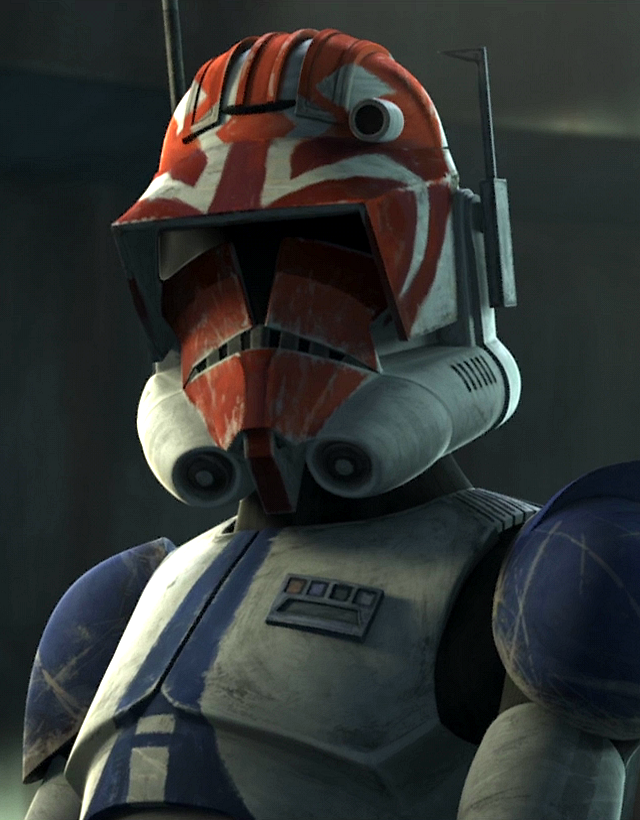
A clone captain using a rank plaque on their armor.
Rank insignia plaques were rectangular metallic plates with colored square tiles that were attached to tunics and armor to denote military rank and position within the respective martial and non-martial organizations of the Galactic Republic and subsequent Galactic Empire. Republic rank insignia plaques were not standardized, and had a system filled with many variants. The following Empire inherited this system, and used them for a time concurrently with new designs. The Empire attempted to slowly transition to a more standardized rank model, and were represented by single row and double row plaques. This created a mixture of non-uniform markings. Imperial rank plaques could also be fitted so that the colored tiles were further apart from each other.
In the Galactic Empire, the color of the tiles indicated the service branch, or in some situations, civilian equivalents. Code cylinders worn in shoulder pockets were also rank or position indicators on occasion. Rank plaques were commonly worn by commissioned Imperial officers on their uniforms, including cloth uniforms or battle armor. While it was theoretically possible to put a comlink in an Imperial rank plaque by hollowing out the tiles from behind, there was not enough room for all the and a proper battery fit for long-range use. However, it was possible to put a functional beckon call into a rank plaque.
The Grand Army of the Republic's non-clone and clone trooper officers used rank insignia plaques to display their rank. Colonel Meebur Gascon had a small rank plaque that consisted of one multi-colored tile. The tile was red with a broad blue vertical stripe at the center. Clone Marshal Commander Cody of the 7th Sky Corps used a modified rank plaque on his Phase II clone trooper armor, consisting of a single row of one blue square, an orange square, and two subsequent blue squares. Clone Captain Vaughn of the 332nd Division used a similar rank plaque. Other officers commonly used rank plaques with two red tiles and one blue tile in a single row.
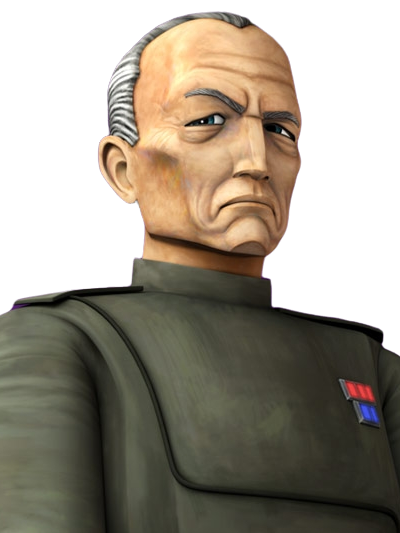
A Republic navy admiral, with a rank insignia plaque denoting their flag officer rank.
Republic rank insignia plaques were not standardized and was filled with multiple variants. Despite this, many Republic Navy officers had identical rank plaques. The rank plaque of three red tiles above two blue tiles was used to denote various naval ranks, including the high rank of adjutant general, fleet admiral, admiral, rear admiral, and a naval captain that served as the fleet commander.
Clone naval officers used a single row system to display their ranks. Clone naval commanders used plaques with two red tiles and one blue tile, which was also used by clone naval captains. Naval corporals wore a plaque with one blue tile followed by two red tiles, which was a common model used throughout the Republic Starfleet. Other clone naval officers, wore a rank plaque with three red tiles in a single row, as well as others who used three blue tiles instead. Another combination used by clone naval officers was three tiles, with one red tile at the center of two blue ones. When army Clone Commanders served in a naval position, they were marked with plaques also using two red tiles and one blue.
Other groups within the Galactic Republic used rank insignia plaques. Lieutenant Commander Orson Callan Krennic of the Republic Special Weapons Group used a rank plaque.
The rank plaque of a Grand Moff.
Imperial governors, including Grand Moffs, Moffs, and planetary governors, consistently used the double row rank insignia model to demonstrate their respective ranks. Grand Moffs and Moffs used a rank plaque with six blue tiles on the top row, and three red tiles followed by three yellow tiles on the bottom row of their plaque. Earlier in the Empire's reign, Moffs could also use plaques with five blue tiles that sat above three red tiles followed by two yellow tiles to signify their rank and title. Grotton, the Imperial governor of the planet Desix, used a rank plaque with two red tiles over two blue tiles that were further separated from each other.
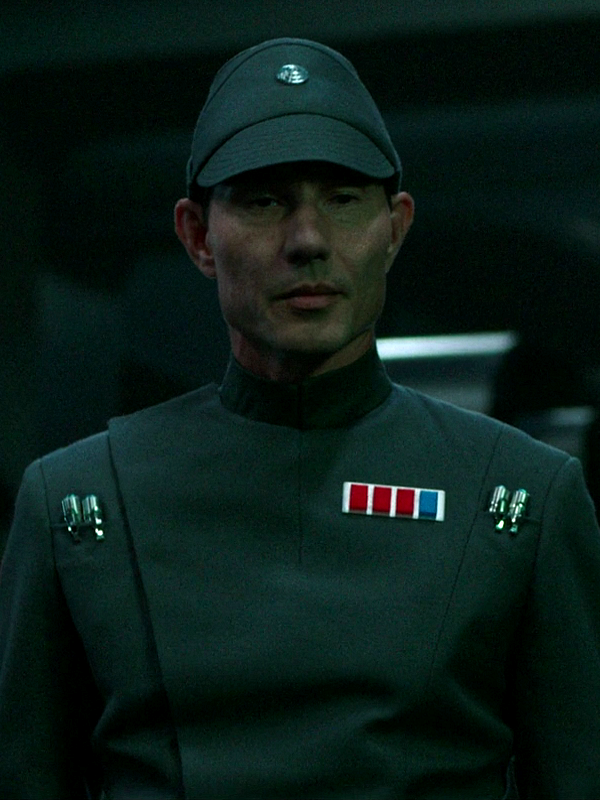
An officer displaying a single row plaque for the rank of captain.
Under the single row rank insignia system, the Imperial Army used various plaques to denote their army ranks. To denote a general, a plaque of six red tiles was used with the standard olive uniform. Such officers included Sotorus Ramda and Cassio Tagge, although Trech Molock used a light gray uniform instead. A colonel in the Imperial Army used a plaque with three red tiles followed by three blue tiles, while a major used three red tiles and two blue. A Clone Commander was able to demonstrate their rank with a distinct rank plaque inherited from Republic service that consisted of four small tiles; one blue, followed by a red tile, and subsequently two more blue tiles. An army captain could either be suited with a single row plaque with four red tiles such as Captain Bragg, or with three red tiles and one blue such as Tala Durith.
Additionally, an army security captain, such as Vanis Tigo, wore a rank plaque of three blue tiles on a black uniform, and four when he was given the title of Prefect. A lieutenant was provided with a rank plaque of three tiles, two red and one blue on a standard uniform. Army lieutenants such as Alayus Bolandin and Mytus Adema used such plaques and uniforms, and the rank of second lieutenant was represented in the same manner. Army security lieutenants, such as Merzin Keysax, used three blue tiles on their black uniform.
Under the double row rank insignia system, a grand general had three blue tiles and three yellow tiles on the top row, and three blue and three red tiles on the bottom row with a standard olive uniform. Generals, including Gollin, Valin Hess, and Maximilian Veers, wore four red tiles over four blue tiles on their standard uniforms to denote their rank. In some instances, the tiles were separated further from each other like the one worn by General Veers while other rank plaques did not separate the color tiles as much, such as the plaque worn by General Hess. The rank plaques with four red tiles and four blue tiles was also implemented to represent colonels such as Barokki, Chief Architect Alva Brenne, and Gralm. However, Army Colonel Bryce had four red tiles above another four red to denote his rank. An army major using the double row model used a rank insignia with four red tiles over four blue, similar to that of a colonel but with one code cylinder instead of two usually worn by colonels.
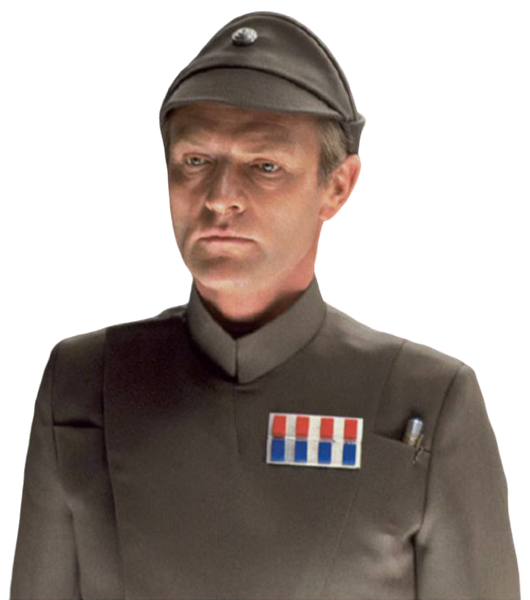
Maximilian Veers with his double row rank plaque denoting his rank of general.
Army officers with the title of commander, such as Altadan Igar, wore three red tiles on the top row of their plaque, and three blue tiles on the bottom row. Under the double row system, army captains like Punfor and Kosh also wore three red tiles over three blue tiles fitted on their olive uniforms.
A captain, however, could also display their rank by wearing a rank plaque with two red tiles over two blue, such as Captain Tanch. Junior officers, such as army lieutenants, also wore two red tiles over two blue tiles under the double row plaque system, such as Lieutenant Sheckil.
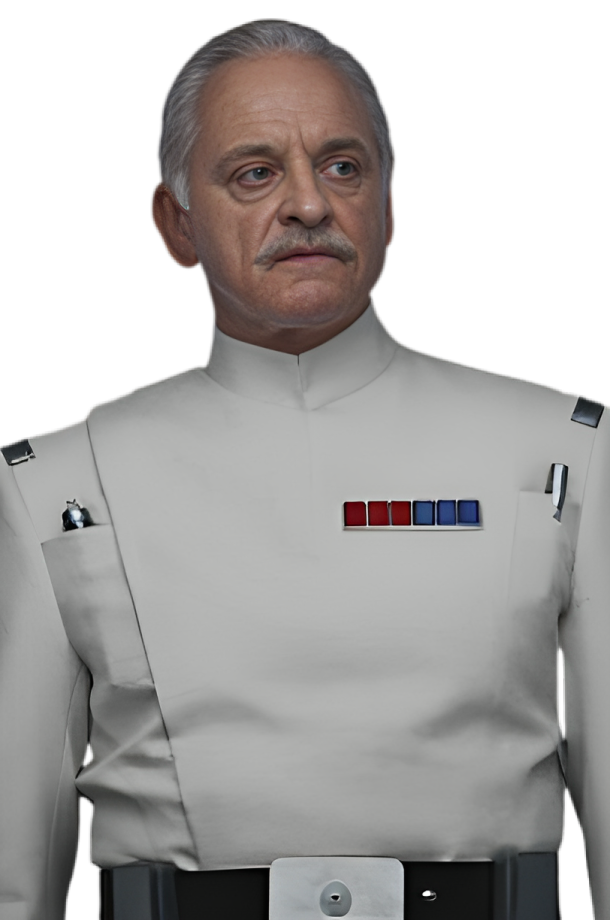
ISB Colonel Yularen, denoting his status and rank with the insignia plaque and epaulets.
The Commission for the Preservation of the New Order and its child agencies such as the Imperial Security Bureau and Coalition for Progress, although not martial departments, also used the Imperial rank plaque system for their own ranks. The Imperial Security Bureau, under the single row system, used three red and three blue tiles to denote the rank of an ISB colonel. Silver epaulets could be worn on the white ISB uniform as a further symbol of status and rank. One such colonel was ISB officer Wullf Yularen. A Senior Commander, exemplified by Alecia Beck, used a single row plaque with red tiles.
ISB commanders, such as Trey Trellen, used the inverse to denote their rank; three blue tiles followed by three red. Despite this, ISB commanders could also use four blue tiles, such as Chief Supervisor Lank Denvik. Other ISB chief supervisors could make use of a single row plaque with one blue tile followed by three red tiles. Standard ISB supervisors conversely made use of a single row plaque with two blue tiles followed by two red. ISB majors, including Lio Partagaz, used five blue tiles to display their ISB rank. ISB captains used four blue tiles, for example ISB Supervisor Lagret. ISB lieutenants, such as ISB Supervisors Dedra Meero, Blevin, and Lonni Jung used three blue tiles on their white uniforms, while other junior officers wore two blue tiles on their uniforms.
Inspector General for the Imperial Center of Military Research on Scarif Bozeden Jeems used a single row plaque with three red tiles and one blue tile. Loyalty officers such as Sid Uddra used the opposite, one blue tile that preceded three red tiles. ISB field agents, such as Alexsandr Kallus, used two blue tiles that was followed by an empty space and subsequently one red tile. When Agent Kallus was promoted and was a commander, his rank was denoted by three blue tiles and two yellow tiles on his combat armor. Other agents, such as Thorn, had three blue tiles followed by a red tile on their white uniform. ISB Attendants, such as Heert and Corv, wore a rank plaque with two blue tiles on their gray uniforms.
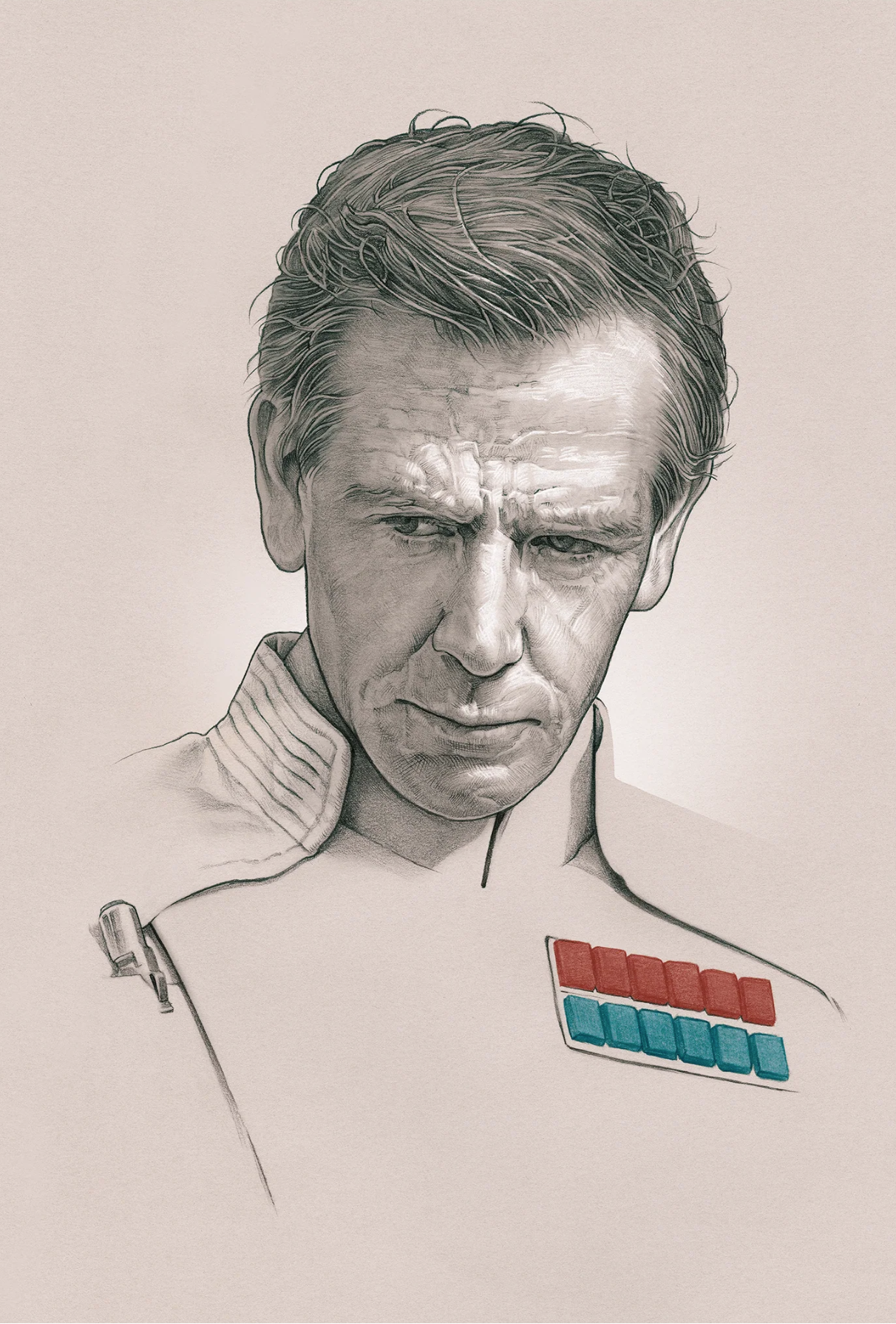
ISB Director of Advanced Weapons Research Orson Krennic.
Using the double row rank plaque system, Director of Advanced Weapons Research and Commander Orson Callan Krennic used an admiral rank plaque of six red tiles above six blue tiles on his white, caped uniform. Earlier in Director Krennic's career, he used a single row plaque with six red tiles to display his rank of lieutenant commander. ISB admirals such as Garrick Versio also denoted their flag rank with six red tiles on top of six blue tiles, as did divisional ISB directors such as Barsha.
Early in the Empire's reign, an ISB major could simply be equipped with a rank plaque of two red tiles over two blue. ISB commanders under this system also used two red tiles over two blue, including Commander Jordo. Using the double row system, ISB field agents used plaques with three blue over three red tiles. ISB officers could also use a rank plaque of three red tiles over three blue tiles on a dark colored uniform with a bandolier.
Other bureaus of COMPNOR such as the Coalition for Progress used the rank plaque system. A captain in the Coalition for Progress was provided with a rank insignia plaque of three red tiles over three blue tiles, like Captain Okma. COMPNOR art director Dasita Lyros used a single row rank plaque of six red tiles on her black uniform.

Edmon Rampart, with his rank plaque demonstrating his rank of vice admiral.
Using the single row rank plaque system that was predominant prior to the Battle of Yavin, the Imperial Navy denoted the naval rank of admiral with six blue tiles on their standard olive uniforms. Such admirals with these rank plaques included Barton Coburn and Gorin. Admiral of the Navy and Chief of the Imperial Navy aboard the DS-1 Death Star Mobile Battle Station Conan Antonio Motti used a single row plaque with two blue tiles followed by four red. This same plaque was used by the Navy's vice admirals, such as Edmon Rampart. Commodores like Almudin under this system wore a plaque with six tiles; three blue followed by three red.
Naval captains, such as Shaef Corssin and the previous captain of the Devastator, wore three blue tiles followed by two red tiles on their standard olive uniform. This same rank plaque could be worn on a black uniform, however, such as Captain Elk. Conversely, early in the Empire's reign, the rank of captain could be represented by four blue tiles. These were carried over from the Republic's system, and the tiles were separated further from each other. One example was the rank plaque worn by Captain Barrow Oicunn. Naval commanders used three blue tiles that preceded a red tile, and could also be used on black uniforms. Other naval commanders wore plaques with four blue tiles that were separated further from each other, such as Pasqual. Naval lieutenants in the single row system used two blue tiles and one red, while a junior lieutenant used two blue tiles. The rank of warrant officer was represented by a single row plaque of four blue tiles, exemplified by the plaque worn by Kronauer. Other junior officers used a two-tiled single row rank plaque, consisting of one red and one blue tile.
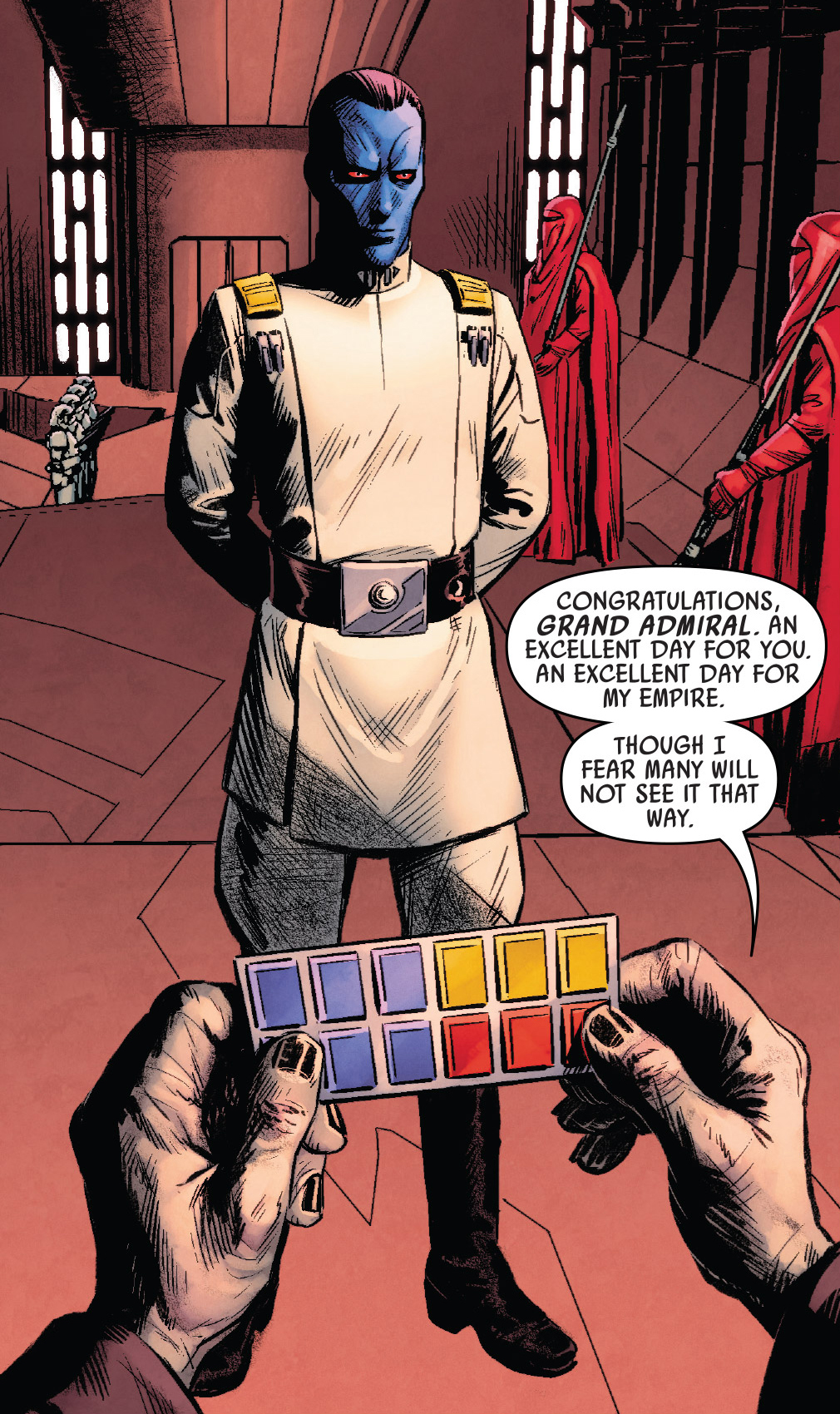
Thrawn was presented with a new rank insignia plaque upon his promotion to Grand Admiral.
Conversely, in the double row model used by the Imperial Navy, admirals were provided with varying types of rank insignia plaques. A grand admiral rank badge had three blue tiles and three yellow tiles in the top row, and three blue tiles followed by three red. The rank of fleet admiral was demonstrated by six red tiles on the top row, and six blue tiles on the bottom row, and was worn by individuals such as Kendal Ozzel. Officers with the rank of admiral were also denoted by six red tiles over six blue like Kassius Konstantine, as well as other rank plaques that included four red tiles over four blue. Such a rank plaque was worn by Admiral Mummert. Another rank plaque that denoted the rank of admiral was three red tiles above three blue, like the plaque worn by Admiral Ektol Traz. The rank of vice admiral, held by individuals such as Rae Sloane, was additionally represented by six red tiles on top of six blue tiles, as was the rank of rear admiral which was held by Chiraneau. Despite this, Sloane also used a rank insignia plaque of five red tiles over five blue tiles during her service as a vice admiral as well.

Admiral Kassius Konstantine, with a rank plaque following the double line model.
The rank of commodore was also represented by different rank plaques under the double row plaque system. One style, such as the one worn by Rae Sloane when she was a commodore, was five red tiles on top of five blue tiles. Another style was four red tiles over four blue, such as the one worn by Commodore Idel, while a third version was a rank plaque that consisted of three red tiles over three blue tiles. The version with six total tiles was worn by Commodore Visler Korda. Capital ship captains such as Terisa Kerrill of the ISD Overseer, Lennox of the Tyrant, and Slavin, commonly used rank plaques of three red tiles over three blue tiles to signify their rank of naval captain. Captain Brunson used this rank plaque, but wore a black uniform. Naval commanders, namely Woldar and Ellian Zahra, wore rank insignia plaques with four red tiles situated above four blue ones. Other commanders such as Befa and Kai wore plaques with three red tiles and four blue tiles on the second row instead. In other instances, commanders such as Nemet wore rank plaques of two red tiles situated above two blue tiles to signify their rank.
In the double row plaque system, the naval rank of lieutenant was also represented by plaques of two red tiles over two blue tiles, however, some plaques had their colored tiles separated further than others. Lieutenants Gorr, Cabbel, and Jyala Haydenn wore these rank plaques to denote their ranks. A junior lieutenant rank under the double row model was denoted using two red tiles over two blue. A rank insignia plaque of one red tile above one blue tile denoted the rank of ensign. Early in the Empire's reign clone naval officers retained their rank plaques from the Republic Navy. These included single row plaques with three blue tiles.
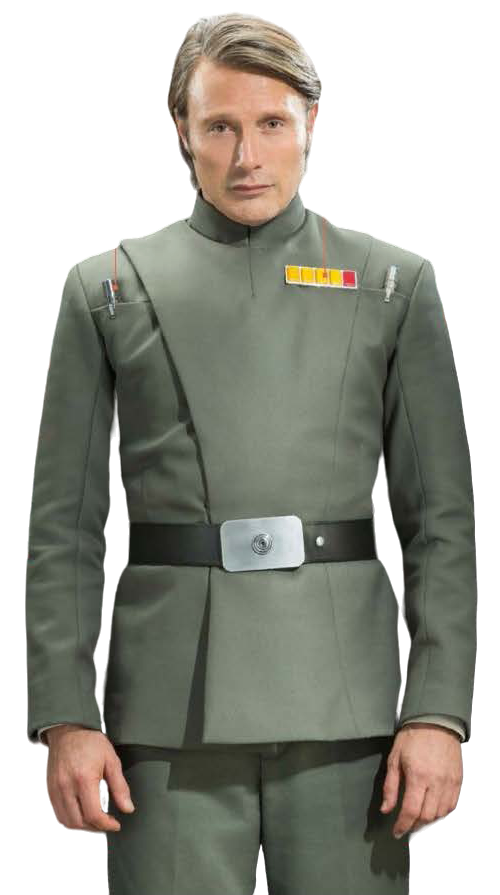
Galen Erso's Science and Engineering Division rank of major is denoted by the insignia plaque on his uniform
The Science and Engineering Division and military officers in operations used single line rank insignia plaques to demonstrate their rank. An operations general was displayed by a single row rank plaque of six yellow tiles, and was worn by individuals such as Hurst Romodi. Subsequently, an operations colonel such as Colonel Soden Petigar wore rank plaques with five yellow tiles followed by a red tile. A Science and Engineering Division Major such as Dr. Galen Walton Erso wore a plaque with four yellow tiles and one red tile. An operations captain wore a plaque with four yellow tiles, and an operations lieutenant wore a rank plaque with three yellow tiles.
The Stormtrooper Corps and other security branches used single row rank insignia plaques as well as double row plaques throughout its history. Using the single row rank plaque system, the rank of general and colonel were denoted by six blue tiles, while a major was represented by five blue tiles. A commander, such as Praji, used four blue tiles followed by two amber tiles. Other commanders, like Daine Jir, were provided with rank plaques containing four blue tiles, which was identical to the rank plaques used by captains. Lieutenants used three blue tiles to represent their rank. Stormtroopers could also display their rank with one blue tile and two red tiles. Under the double row model, a stormtrooper captain used a rank plaque with two red tiles over two blue tiles on their armor. Sergeant majors wore rank insignias with blue tiles on their black uniforms.
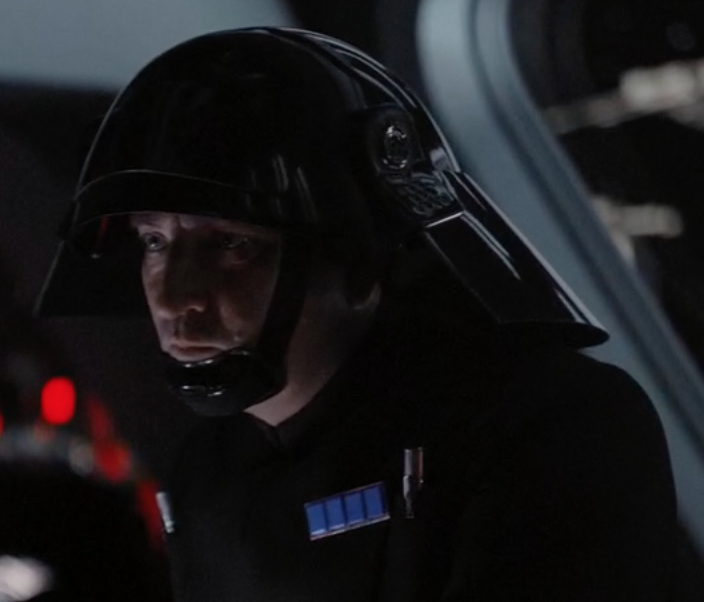
Rank plaques were used throughout the Imperial Armed Forces.
The Imperial Starfighter Corps, a branch within the Imperial Navy, used rank plaques as well. Starfighter Corps Colonel Shakara Nuress used a double row rank plaque with four red tiles over four blue ones to display her rank on her olive uniform. Majors such as Soran Keize used the same rank plaque, but outfitted on a gray uniform. Also within the Imperial Navy, Imperial Navy Troopers occasionally utilized rank plaques. When used, they included single row rank plaques with four blue tiles while others wore single row with red tiles. The Inspectorate used both single and double lined rank plaques. An Inspectorate commander wore the standard plaque with four red tiles over four blue. Captain-Inspector was demonstrated by three red tiles followed by a blue tile, Inspector was denoted by three red tiles on top of three blue, and Lieutenant-Inspector used multiple blue tiles.

There were many types of rank plaques throughout the Galactic Empire.
Rank plaques were used by various individuals within the vast expanse of the Galactic Empire. Admiral Brom Titus used a rank plaque with a single row that consisted of four red tiles followed by two yellow on his black uniform. When Titus was demoted to commander, his rank was simply displayed by a plaque with two red tiles. Chief Manager of the Death Star General Moradmin Bast had his rank displayed by four yellow tiles and two red tiles on a single row plaque, which was also used to display Chief Siward Cass's rank as well. Lieutenant Oon-ai, who served as an adjutant to Grand General Cassio Tagge, had a rank plaque with six blue tiles on a singular lined plaque. The aide of Lieutenant Pol Treidum wore two red tiles on a black uniform.
A commandant's rank was signified in several ways; a single row rank plaque with several red and yellow tiles, a single row plaque with four blue tiles and two red tiles pinned on a modified uniform such as the one worn by Jayhold Beehaz, or a double rowed plaque with three red tiles on top of three blue tiles. A sergeant major who held the title of taskmaster used the same double row plaque as a commandant. Crix Madine, an Imperial Special Forces officer who eventually obtained the rank of general, used a rank plaque with a singular row of two blue tiles followed by four red tiles at one point in his career.
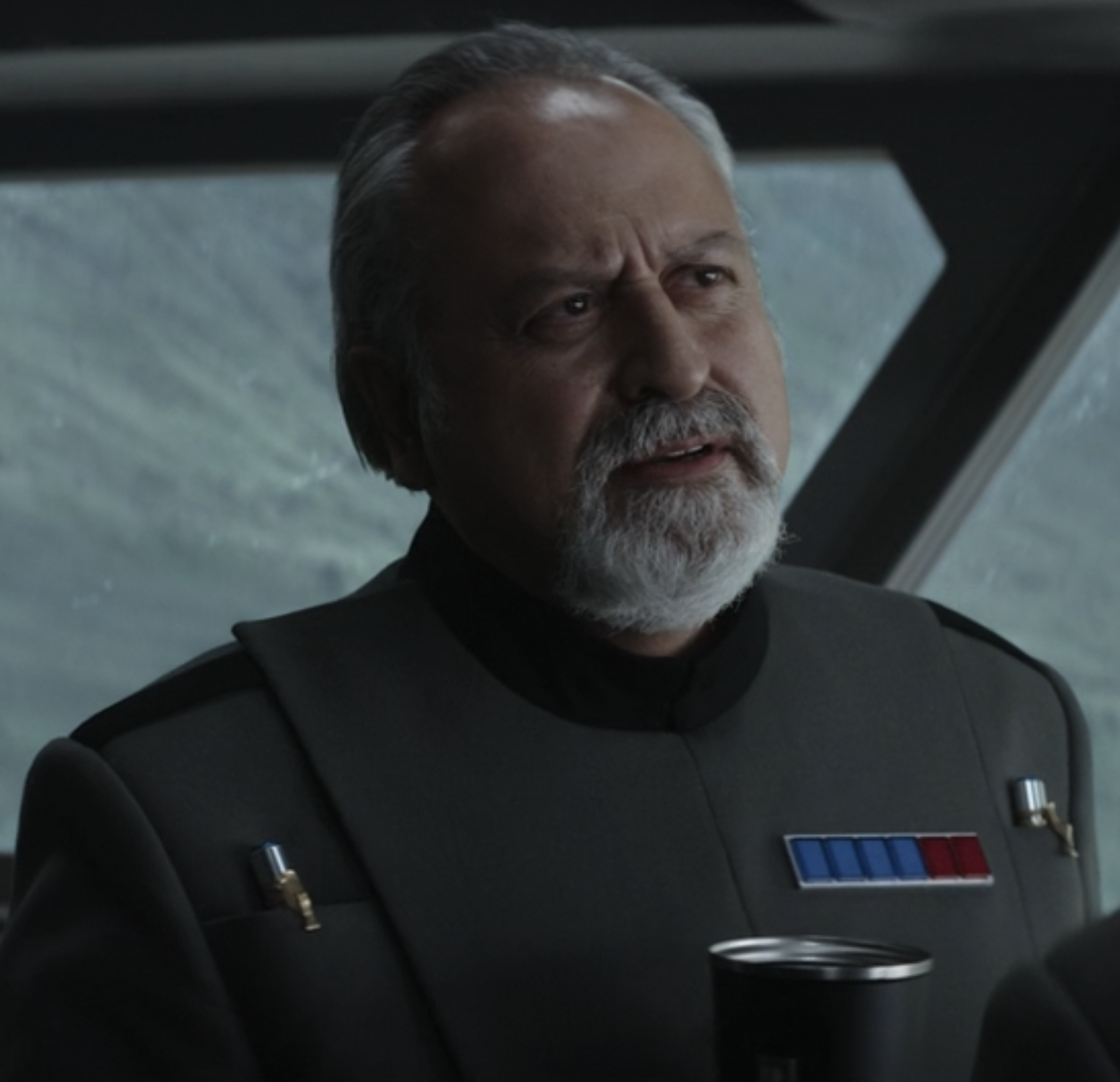
Jayhold Beehaz's rank plaque represented that of a commandant.
Other rank plaques included six red tiles and five red tiles on a single row on a black uniform, three red tiles on a single row that was also applied to officers in black uniforms, a single row rank plaque with four yellow tiles and two red tiles on a black uniform, a single row plaque with three red followed by three yellow tiles on a gray uniform, and a single row plaque with three blue tiles that preceded a red tile and followed by another blue tile. Others, like Captain Edmos Khurgee, had six yellow tiles on a single row rank plaque, or a single row plaque with four blue tiles followed by two yellow. There were also officers who used standard uniforms with a single row plaque consisting of five blue tiles.
Imperial interrogation officers could use a rank plaque of four red tiles on the top row, and four blue tiles on the bottom to show their rank. The rank plaque's tiles were further separated from each other than on other plaques. Other interrogation officers used a singular row plaque with five red tiles. Subordinate lieutenants of a prison used rank plaques with at least two red tiles in a single row. Prosecutors of the Imperial justice system used sand brown uniforms with a single row rank plaque of two yellow tiles followed by a red tile. Imperial weapons technicians of a certain rank also used a single row rank plaque, which consisted of four red tiles. An Imperial cadet with the rank of Cadet First Class was provided with a single blue tile to represent their rank.
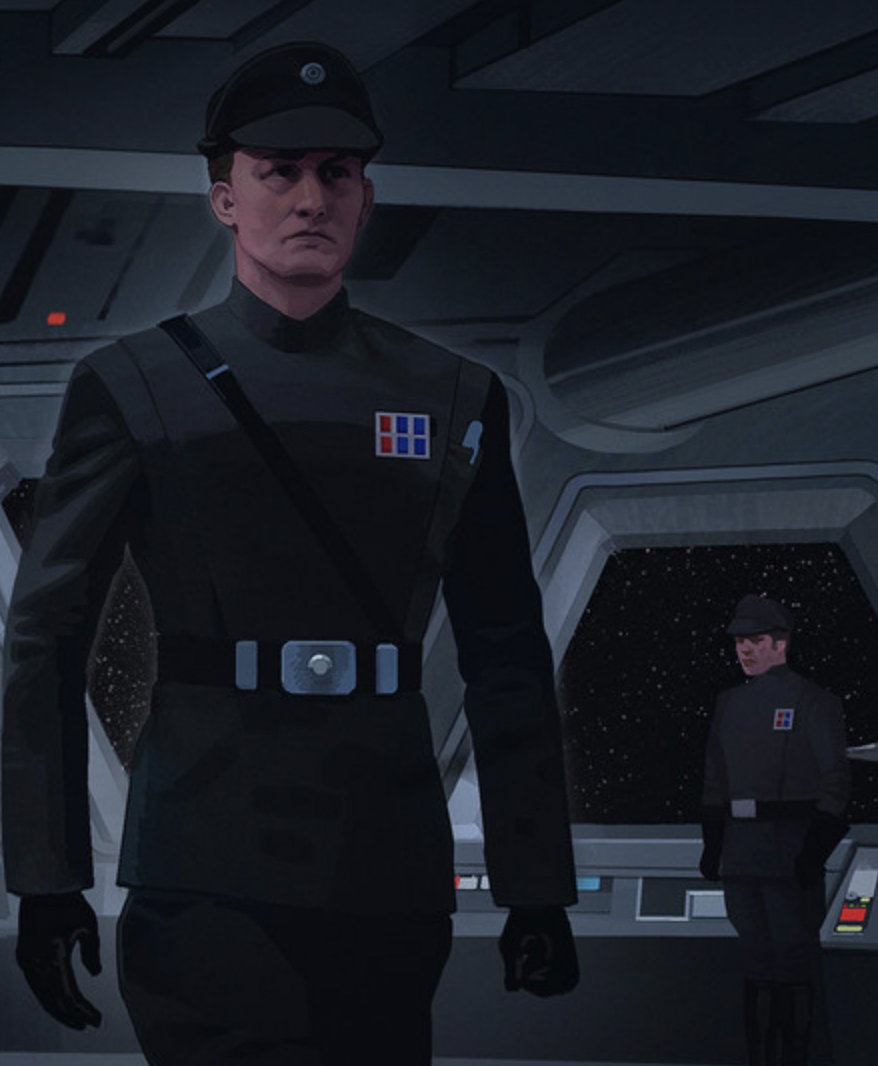
The distinct rank plaques used by Adelhard's Imperial remnant.
Following the splinter of the Galactic Empire into various waring remnants, many remnants continued the rank insignia model of double rows, including those on Morak and the remnant led by Moff Gideon. The Imperial remnant in the Anoat sector, however, used a different color system on their double row rank plaques. Officers used double row plaques, but with one red tile followed by two blue tiles on the top row, and duplicated on the second row.
Major Jaidra and Captain Thenn's ranks used these rank plaques. Subordinates were provided with plaques that had one red tile and one blue tile on the top row that was also replicated on the bottom row. These plaques were complemented by a black sash that traversed the chest and torso.
Rank insignia plaques were implemented by the Galactic Republic by the start of the Clone Wars to denote and visualize military ranks of its officers. The rank insignia system was filled with variants, creating a non-standard model. As the Republic transitioned into the Galactic Empire, these same rank insignias remained in use initially as the Empire inherited the Republic system. New designs were made following the transition from the Republic, but these were sector-specific, creating a mixture of non-uniform markings.

The Empire adopted a variant-filled system of rank plaques from the Republic.
By the time shortly prior to the Battle of Yavin, the Imperial rank insignia system was undergoing a slow transition to a more standardized model. Single line plaques at this time were the norm, and were being replaced by double line plaques, although double line plaques were implemented since the birth of the Empire to some extent. Following the collapse of the Empire during the Galactic Civil War, the Imperial Remnants continued use of the Empire's double line plaques. Factions that salvaged Imperial armor and uniforms such as the Warbird gang, used the rank plaques as customizable pieces.
The rank insignia plaque first appeared in the 1977 movie Star Wars: Episode IV A New Hope, although they were unnamed. They received identification in the 2014 reference book Star Wars Rebels: The Visual Guide. Costume designer Glyn Dillon has released an Imperial rank chart reconstructed by co-designer and military expert David Crossman for use on Rogue One and Solo: A Star Wars Story.
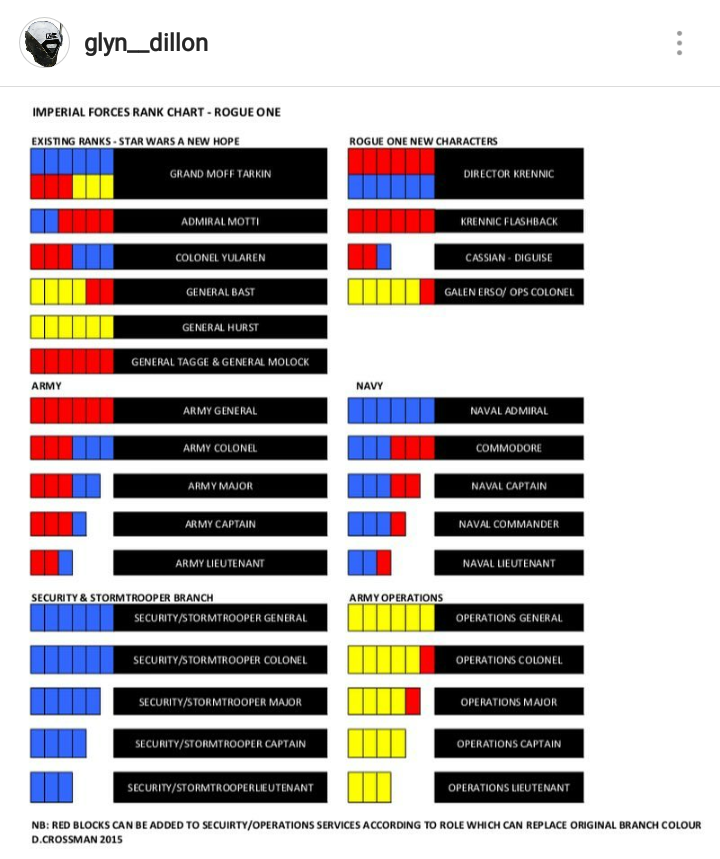
Imperial Forces Rank Chart released by Glyn Dillon and created by David Crossman for Rogue One
According to Pablo Hidalgo, the rank badges "only mean anything in Empire Strikes Back." In A New Hope, the plaques look different than in The Empire Strikes Back, despite many officers holding the same rank. In Return of the Jedi, all of the plaques were mistakenly made as commander plaques due to a costuming error, even those of Admiral Firmus Piett and Moff Tiaan Jerjerrod. However, in the scene where Darth Vader arrives aboard the Death Star II, several frames of the scene depict the same officers with the two rows of three tiles with two rows of four tiles. Both Rogue One: A Star Wars Story and Star Wars Rebels feature both styles of plaques.
In 2022, Pablo Hidalgo clarified that there exist two eras for Imperial rank badges, pre-Death Star destruction and post. The pre-Death Star destruction era features the 'single row' template developed for Rogue One and also used in Kenobi and Andor. Pablo further stated that the rank plaques evolved over time, and only apply to the film and series owing to the 'double row' version being used in Rebels and the comics, and that it took a while to trickle into other media. Star Wars: Dawn of Rebellion: The Visual Guide later established that the Imperial Military inherited a variant-filled system from the Republic, and that the rank insignia plaques of the Empire were undergoing a transition to a more standardized model. The Visual Guide established two in-universe eras per Pablo's previous reasoning; a pre-Yavin single row system and a post-Yavin one. The Visual Guide, however, contradicts information established in the TV series Andor, dictating that ISB majors wore four blue tiles, captains wore three, and lieutenents wore two. The series, however, establishes that ISB majors wore five, captains wore four, and lieutenants wore three.
Lastly, Pablo clarified that it was a "safe assumption" that the 'Army Operations' in the single row chart were the equivalent of Battle Station Operations, with it being composed of "basic non-combat ops. engineers and whatnot." Star Wars: Dawn of Rebellion: The Visual Guide later established that such plaques belonged to the Science and Engineering Division.
In Inspector Thanoth's debut issue, Darth Vader (2015) 8, he wore a rank insignia featuring three blue squares over three red. However, in all subsequent issues, up until his death in Darth Vader (2015) 20, he wore a plaque with three red over three blue. This article assumes the more recent and more numerous depiction of the plaque is correct. Throughout the Star Wars: Thrawn comic series, the colors on rank plaques are inverted, with blue on top and red at the bottom row. In "The Path of Anger," Gilad Pellaeon is depicted as wearing an Imperial Army captain rank plaque, despite being a naval officer. The character poster for Edmon Rampart in the third season of Star Wars: The Bad Batch depicts him with a commodore's rank plaque, despite wearing a naval captain's plaque in the series and Rampart impersonating a captain.
- "Far Too Remote" — From a Certain Point of View
- LEGO Star Wars: Choose Your Side: Doodle Activity Book
- The Art of Star Wars: Visions